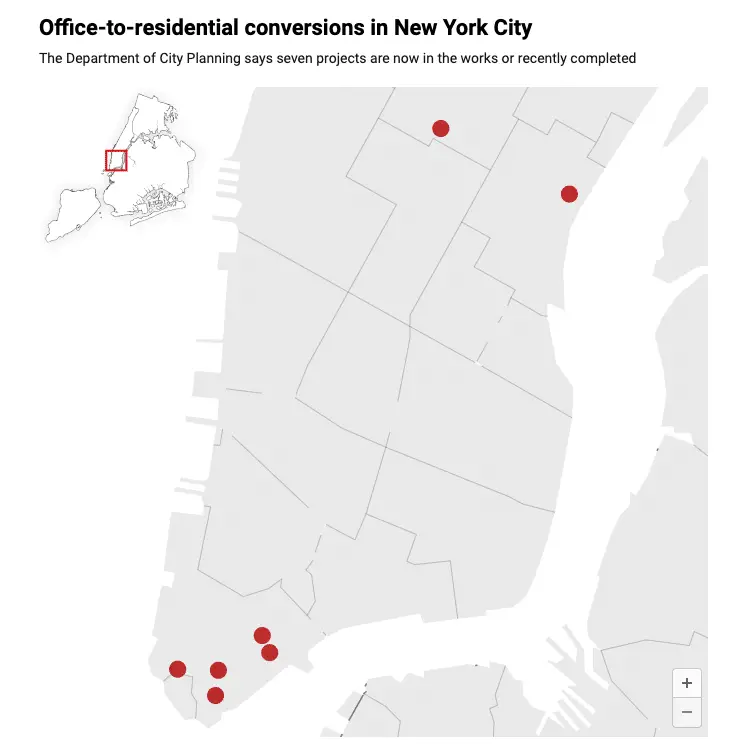New York City plans a significant office building repurposing effort to address its housing shortage. 64 office buildings could become new housing, transforming the city’s skyline and providing much-needed residential space. This initiative aligns with ongoing efforts to adapt to changing urban needs.

The Vision Behind Office Building Repurposing
NYC officials envision a future where underutilized office spaces serve the community better. Converting office buildings to housing offers a practical solution to the city’s housing crisis. This adaptive reuse strategy makes efficient use of existing structures, saving on construction costs and reducing environmental impact.
Insights from the Office Conversion Accelerator Program
According to the Department of City Planning, owners of 64 office buildings are interested in converting their properties into housing. These owners have contacted the Office Conversion Accelerator Program, designed to help navigate complex rules and building codes. This initiative supports Mayor Eric Adams’ goal of transforming offices into 20,000 apartments over the next decade.

Benefits of Office-to-Residential Conversions
- Address the city’s growing demand for housing.
- Revitalize neighborhoods by bringing new residents and boosting local economies.
- Reduce the environmental footprint compared to new construction by repurposing existing structures.
Challenges in Office Building Redevelopment
- Zoning laws and building codes need adjustments to facilitate these conversions.
- Financial viability of such projects can be complex, requiring incentives and support from the city.
- Overcoming these hurdles is essential for successful adaptive reuse projects.
Progress and Success Stories
So far, four buildings involved in the accelerator program have successfully converted or begun construction, creating about 2,100 new apartments. Notably, buildings at 650 First Ave. and 980 Sixth Ave. have received permits to start renovations. City Planning Director Dan Garodnick describes these office conversions as a “win-win-win,” benefiting commercial real estate, housing availability, and neighborhood vibrancy.

NYC’s Housing Crisis and Innovative Solutions
New York City’s housing crisis demands innovative solutions like office building repurposing. By transforming office spaces into residential units, the city can provide affordable housing options. This approach also supports sustainability by reusing existing structures instead of new builds.
Current Market Realities
Despite the promise of thousands of new apartments, affordability remains a concern. Converted units at 100 John St. rent for $3,695 a month, while median rents in the Financial District approach $5,000. Meanwhile, Manhattan’s office vacancy rate was 18% in early 2023, highlighting the potential for more conversions. In contrast, housing availability remains scarce, with only 1.4% of apartments vacant last year.

FAQ
What is office building repurposing?
Office building repurposing involves converting unused office spaces into residential housing. This process helps address housing shortages and revitalizes urban areas.
Why is New York city focusing on office-to-residential conversions?
NYC focuses on these conversions to tackle the housing crisis and make efficient use of existing structures. This approach offers an environmentally friendly solution to the city’s housing needs.
What are the challenges of repurposing office buildings?
Challenges include navigating zoning laws, ensuring financial viability, and adapting building codes. Overcoming these obstacles requires coordinated efforts between the city and developers.
Related posts:
 Decline in Home Prices: Anticipating a Shift in 2024
Decline in Home Prices: Anticipating a Shift in 2024
 Maryland Governor Legislative Agenda: Military Families, Housing, and Public Safety in 2024
Maryland Governor Legislative Agenda: Military Families, Housing, and Public Safety in 2024
 Nashville’s Zoning Bills for Middle-Income Housing Spark Contentious Debate
Nashville’s Zoning Bills for Middle-Income Housing Spark Contentious Debate
 Tampa Affordable Housing Initiative Breaks Ground on New 188-Unit Building
Tampa Affordable Housing Initiative Breaks Ground on New 188-Unit Building
 Navigating the Decline: Florida Condo Prices Dropping Amidst Rising Costs
Navigating the Decline: Florida Condo Prices Dropping Amidst Rising Costs



